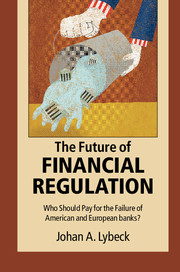Book contents
- Frontmatter
- Dedication
- Contents
- List of figures
- List of tables
- List of boxes
- Preface
- Acknowledgements
- List of abbreviations
- Introduction
- Part I A chronological presentation of crisis events January 2007 – December 2014
- Part II Bail-out and/or bail-in of banks in Europe: a country-by-country event study on those European countries which did not receive outside support
- Part III Bail-out and/or bail-in of banks in Europe: a country-by-country event study on those European countries which received IMF/EU support
- Part IV The TARP program and the bailing out (and bailing in) of US banks
- 13 The roles of the FDIC, the Treasury and the Fed in the crisis
- 14 USA: Bear Stearns, Merrill Lynch and Lehman Brothers
- 15 USA: Countrywide, IndyMac, Washington Mutual and Wachovia
- 16 USA: AIG, Citibank and Bank of America: zombies too big to fail?
- Part V Summary of the micro studies
- Part VI Political and regulatory responses to the crisis: to bail out or to bail in, that's the question
- Conclusion: toward host-country supervision and resolution?
- Addendum
- Bibliography
- Index
15 - USA: Countrywide, IndyMac, Washington Mutual and Wachovia
from Part IV - The TARP program and the bailing out (and bailing in) of US banks
Published online by Cambridge University Press: 05 February 2016
- Frontmatter
- Dedication
- Contents
- List of figures
- List of tables
- List of boxes
- Preface
- Acknowledgements
- List of abbreviations
- Introduction
- Part I A chronological presentation of crisis events January 2007 – December 2014
- Part II Bail-out and/or bail-in of banks in Europe: a country-by-country event study on those European countries which did not receive outside support
- Part III Bail-out and/or bail-in of banks in Europe: a country-by-country event study on those European countries which received IMF/EU support
- Part IV The TARP program and the bailing out (and bailing in) of US banks
- 13 The roles of the FDIC, the Treasury and the Fed in the crisis
- 14 USA: Bear Stearns, Merrill Lynch and Lehman Brothers
- 15 USA: Countrywide, IndyMac, Washington Mutual and Wachovia
- 16 USA: AIG, Citibank and Bank of America: zombies too big to fail?
- Part V Summary of the micro studies
- Part VI Political and regulatory responses to the crisis: to bail out or to bail in, that's the question
- Conclusion: toward host-country supervision and resolution?
- Addendum
- Bibliography
- Index
Summary
There is only one difference between the four banks studied in this chapter and the three financial institutions discussed in the next chapter. The four banks mentioned in the title above were indeed big financial institutions, but they were not too big to fail. And fail they did or would have had they not been saved by merger with a “white knight.” AIG, Citigroup and Bank of America, on the other hand, were “too big to fail.” Hence the treatment they (and their creditors) received was vastly different. In one case discussed in this chapter (Washington Mutual), even senior creditors lost out, in another (IndyMac) not only creditors but even uninsured depositors were hit; in the second case, everybody was saved, including counterparties to derivative transactions, unsecured bondholders and even shareholders.
Countrywide
By the end of 2006, 20 percent of new mortgage lending in the United States consisted of subprime loans and the biggest subprime lender was Countrywide Financial Services. The holding company contained one subsidiary for mortgage banking, Countrywide Mortgage Banking, which originated and securitized mortgages but which was not a bank. Its sister, the savings bank Countrywide Bank, had a national banking license; it was supervised by the Office of Thrift Supervision (OTS), financing mortgage lending by its own deposits. Together they were by far the largest mortgage lender in the United States in 2006 with one-quarter of the entire US market for new residential mortgages and 17 percent of the stock outstanding. Another subsidiary in the group, Countrywide Financial Markets, was licensed as a broker-dealer, financed by issuing asset-backed commercial paper (ABCP), trading and underwriting mortgage-backed securities. Thus one subsidiary in the Countrywide Financial Services group underwrote issues of another subsidiary, a very risky combination as it would turn out when markets crashed in 2007. The fourth member of the group was Countrywide Warehouse Lending, which provided short-term lines of credit to mortgage bankers which used these funds to originate loans later sold to Countrywide.
A large part of mortgage loans originated by Countrywide Mortgage Banking was securitized and sold to investors. The major purchaser of Countrywide's loans was Fannie Mae. In 2004, Countrywide supplied 26 percent of all loans purchased by Fannie; in 2007, the figure had risen to 28 percent.
- Type
- Chapter
- Information
- The Future of Financial RegulationWho Should Pay for the Failure of American and European Banks?, pp. 334 - 357Publisher: Cambridge University PressPrint publication year: 2016



